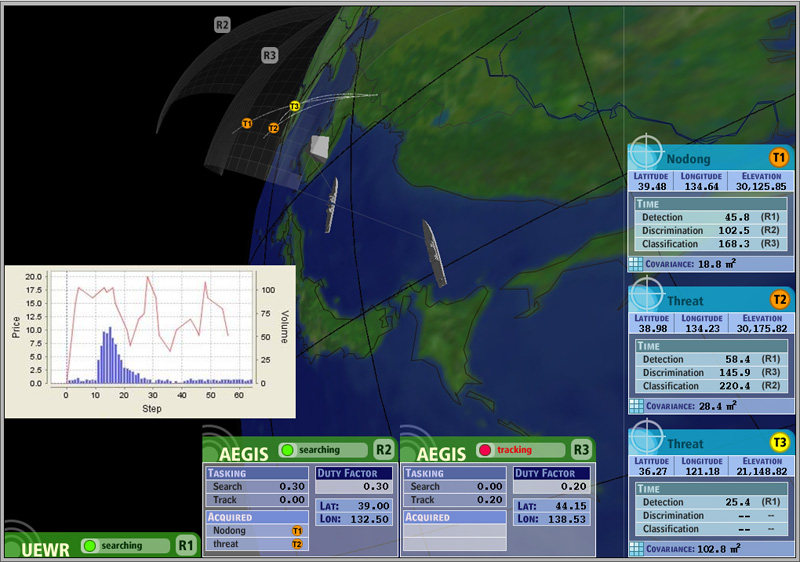Charles River Analytics, a developer of cutting-edge technologies for intelligent systems, announced a number of recent contract awards from the Department of Defense (DoD) to apply optimization technologies to a variety of current and future decision-support and battle management systems. The Air Force Research Lab (AFRL), the US Army Corps of Engineers, and the Missile Defense Agency (MDA) have independently selected Charles River to help solve their real-world operational planning and execution problems by applying a number of powerful optimization technologies, including Evolutionary Algorithms and Market-Based Optimization.
AFRL awarded a 2-year, $750,000 contract to Charles River to develop an architecture for Perceptual Sensing and Information Displays (PERSEID). PERSEID generates plans tailored to a Commander’s needs to deploy information-gathering assets, such as unmanned air vehicles. Additional tools then process the incoming data and present it to the decision maker based on their current tasks and decision-making needs.
“We are researching how current operational context and user preferences, such as Commander’s intent, influence the gathering and understanding of intelligence, surveillance, and reconnaissance (ISR) data,” explained Brad Rosenberg, Senior Scientist at Charles River. “Currently, automated systems do not include this information in the planning process, and that can undermine operator trust in those systems. Our goal with PERSEID is to increase trust during human-machine collaboration.”
Charles River’s PERSEID is the most recent in a series of efforts that use Evolutionary Algorithms (EAs)—a type of optimization technology—for military mission planning. These efforts originated with Charles River’s Software Toolkit for Optimizing Mission Plans (STOMP), which rapidly generates, evaluates, and visualizes air campaign mission plans for dynamic targeting in Air Operations Centers (AOCs). STOMP’s underlying EA technology was then expanded to support intelligence collection planning under the Air Force-funded Integrated ISR Plan Analysis & Rehearsal System (I2PARS) that generates optimized intelligence collection plans. This approach is currently being extended under a contract with the US Army Corps of Engineers called Spatially Produced Airspace Routes from Tactical Evolved Networks (SPARTEN). SPARTEN generates mission plans for a constellation of unmanned aerial vehicles (UAVs) with multi-objective flight goals.
Optimization technologies have broader applications; they are not only limited to planning missions for airborne assets. Recently, the Air Force invited Charles River to extend their efforts in EA-based planning to allocate space-based resources. The Resource Relationship Management for Defensive Counterspace (RRM4DCS) project manages assets for the space domain, an area that provides similar challenges for optimization.
The Missile Defense Agency has also seen the utility of Charles River’s optimization technologies. MDA recently awarded a contract to Charles River to apply advanced Market-Based Optimization (MBO) techniques to problems that occur when rapidly allocating missile defense assets. The Arbitrage Look-ahead Agents for Market-based Optimization (ALAMO) project is a two-year effort to apply concepts from game theory and economics to create algorithms that quickly and dynamically allocate sensors to track incoming ballistic missiles.
ALAMO is the latest follow-on effort to expand and improve upon two previous projects conducted for the MDA to explore the benefits of applying MBO to missile defense applications. The first effort was Sensor Network Optimization using Multi-Agent Negotiation (SNOMAN), an approach that improves sensor performance for missile defense by treating sensors like buyers and sellers in a virtual market. This technique was then improved under Optimized Planning for Threat Interception using Markets for Uncertainty Management (OPTIMUM), which uses MBO to optimize missile defense fire-control while providing a decision rationale to human operators.
The SNOMAN display
Charles River was also recently awarded a contract from the MDA to design the Simulation Optimization Engine (SIMON), which applies previously developed EA techniques to the missile defense domain. In conjunction with a Ballistic Missile Defense System (BMDS)-level simulation, SIMON discovers optimal parameter sets that can be used to iteratively design and test more effective missile defense systems.
Research in novel search and optimization techniques, such as EAs and MBO, provide powerful new techniques to improve military mission planning. However, currently, there is no method that compares the relative strengths and weaknesses of these new optimization approaches. To address this area of study, AFRL is currently sponsoring Charles River’s design of an ISR Constellation Visualization and Investigative Evaluation Workbench (ICONVIEW). ICONVIEW provides an analytical research environment capable of specifying scenario models, designing effectiveness metrics, executing simulations, and evaluating the results. ICONVIEW includes a method to evaluate and contrast different management algorithms for ISR mission planning.
Daniel Stouch, Senior Software Engineer at Charles River explained, “ICONVIEW will provide the Air Force with an objective means of comparing different ISR constellation management algorithms using advanced visualization techniques to identify which one will be the best to use in any given scenario.”
Dr. Scott Neal Reilly, Charles River Analytics’ Vice President of Decision Management Systems said, “We are very excited to be a key performer in these critical programs. We have spent many years refining these optimization techniques and learning how to apply them to real-world problems. We are glad to be increasingly recognized across the DoD as a source of expertise in a broad variety of cutting-edge optimization technologies. Our innovative solutions can be applied to a wide range of modern defense applications, including mission planning systems, battle management algorithms, and analysis tools.”
Approved for Public Release
09-MDA-4892 (16 SEPT 09)

